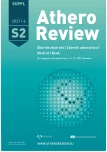01ÚS Labetalol treatment exacerbates estrogen-induced liver damage
01ÚS Labetalol treatment exacerbates estrogen-induced liver damage
Introduction: Soluble endoglin (sEng) is an important biomarker involved in the pathogenesis of preeclampsia, a disease characterized by high blood pressure, proteinuria and high soluble endoglin levels. Preeclampsia and intrahepatic cholestasis are serious complications of pregnancy, which threaten mothers and fetuses with adverse outcomes such as preterm delivery, or stillbirth. Clinical studies revealed a strong co-incidence of both pathologies, nevertheless, the cause of the simultaneous worsening of liver functions is unknown. Labetalol, an alpha-/beta-adrenergic receptor antagonist is recommended in the therapy of hypertension in preeclampsia, however the treatment was linked to drug-induced liver damage and intrahepatic cholestasis. Aim: Therefore, in this study we aimed to elucidate the effect of labetalol therapy on bile acid formation and metabolism in an animal model of estrogen-induced intrahepatic cholestasis. Methods: Four-month-old wild-type female mice were daily administrated with ethinylestradiol – EE (10 mg/kg s.c.) for 5 days, as estrogen-induced intrahepatic cholestasis model. Concomitant administration of EE (10 mg/kg s.c.) and labetalol (10 mg/kg s.c.) during same period was used to simulate intrahepatic cholestasis and antihypertensive treatment in pregnancy. At last, animals underwent clearance in vivo study with bile collection and plasma biochemical analysis was performed. Expression of enzymes and transporters in liver were assessed by qRT-PCR and Western blot. Results: Induction of intrahepatic cholestasis was determined by reduction of bile flow rate associated with elevation of plasma activity of liver enzymes (alkaline phosphatase and alanine transaminase), and total bilirubin levels. Additionally, increased plasma levels of sEng were observed in estrogen-induced cholestasis. Concomitant administration of labetalol with EE reduced bile flow rate, resulting in worsening of cholestatic effect of EE, by modulation of protein expression of hepatic bile acids efflux transporters (Bsep and Mrp4), and additional increase in plasma sEng levels. Moreover, increased plasma levels of sEng result in exacerbation of cholestasis and liver dysfunction. Conclusion: These data demonstrate that labetalol treatment aggravates ethinylestradiol-induced intrahepatic cholestasis, suggesting the importance of liver function assessment in preeclampsia and intrahepatic cholestasis patients during labetalol treatment.
Autoři:
Igreja E Sá Ic 1; Faradonbeh Fa 2; Hroch M 3; Lastuvkova H 2; Tripska K 1; Pericacho M 4; Micuda S 2; Nachtigal P 1
Působiště autorů:
Department of Biological and Medical Sciences, Faculty of Pharmacy in Hradec Kralove, Charles University, Czech Republic
1; Department of Pharmacology, Faculty of Medicine in Hradec Kralove, Charles University, Czech Republic
2; Department of Biochemistry, Faculty of Medicine in Hradec Kralove, Charles University, Czech Republic
3; Biomedical Research Institute of Salamanca and Renal and Cardiovascular Physiopathology Unit, Department, of Physiology and Pharmacology, University of Salamanca, Salamanca, Spain
4
Vyšlo v časopise:
AtheroRev 2021; 6(Supplementum 2): 7
Kategorie:
Specifické rizikové faktory kardiovaskulárních onemocnění
Souhrn
Introduction: Soluble endoglin (sEng) is an important biomarker involved in the pathogenesis of preeclampsia, a disease characterized by high blood pressure, proteinuria and high soluble endoglin levels. Preeclampsia and intrahepatic cholestasis are serious complications of pregnancy, which threaten mothers and fetuses with adverse outcomes such as preterm delivery, or stillbirth. Clinical studies revealed a strong co-incidence of both pathologies, nevertheless, the cause of the simultaneous worsening of liver functions is unknown. Labetalol, an alpha-/beta-adrenergic receptor antagonist is recommended in the therapy of hypertension in preeclampsia, however the treatment was linked to drug-induced liver damage and intrahepatic cholestasis. Aim: Therefore, in this study we aimed to elucidate the effect of labetalol therapy on bile acid formation and metabolism in an animal model of estrogen-induced intrahepatic cholestasis. Methods: Four-month-old wild-type female mice were daily administrated with ethinylestradiol – EE (10 mg/kg s.c.) for 5 days, as estrogen-induced intrahepatic cholestasis model. Concomitant administration of EE (10 mg/kg s.c.) and labetalol (10 mg/kg s.c.) during same period was used to simulate intrahepatic cholestasis and antihypertensive treatment in pregnancy. At last, animals underwent clearance in vivo study with bile collection and plasma biochemical analysis was performed. Expression of enzymes and transporters in liver were assessed by qRT-PCR and Western blot. Results: Induction of intrahepatic cholestasis was determined by reduction of bile flow rate associated with elevation of plasma activity of liver enzymes (alkaline phosphatase and alanine transaminase), and total bilirubin levels. Additionally, increased plasma levels of sEng were observed in estrogen-induced cholestasis. Concomitant administration of labetalol with EE reduced bile flow rate, resulting in worsening of cholestatic effect of EE, by modulation of protein expression of hepatic bile acids efflux transporters (Bsep and Mrp4), and additional increase in plasma sEng levels. Moreover, increased plasma levels of sEng result in exacerbation of cholestasis and liver dysfunction. Conclusion: These data demonstrate that labetalol treatment aggravates ethinylestradiol-induced intrahepatic cholestasis, suggesting the importance of liver function assessment in preeclampsia and intrahepatic cholestasis patients during labetalol treatment.
Štítky
Angiologie Diabetologie Interní lékařství Kardiologie Praktické lékařství pro dospěléČlánek vyšel v časopise
Athero Review

2021 Číslo Supplementum 2
- Isoprinosin je bezpečný a účinný v léčbě pacientů s akutní respirační virovou infekcí
- Metamizol jako analgetikum první volby: kdy, pro koho, jak a proč?
- Není statin jako statin aneb praktický přehled rozdílů jednotlivých molekul
Nejčtenější v tomto čísle
- 08ÚS Multifaktoriální chylomikronemie
- 09ÚS Post mortem vyšetření náhlé srdeční smrti: výstupy
- 26PS Využití chytrých hodinek ke kardiorehabilitaci pacientů po infarktu myokardu: pilotní výsledky studie SmartRehab.
- 01ÚS Labetalol treatment exacerbates estrogen-induced liver damage
